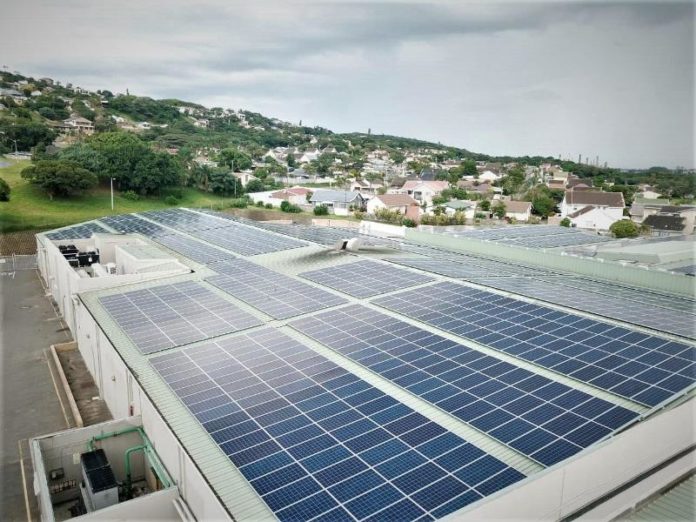Commercial and industrial battery storage solutions can revolutionise the way an organisation consumes energy. Business energy costs are an ever-increasing frustration and account for a large portion of its bottom line. Investing in the appropriate battery storage solution can save businesses a great deal of money, transforming their energy cost profile and ultimately its profit margin.
Batteries are effective in the following scenarios:
- Curtailment reduction/deferral: Storing excess generation for use when it is required.
- Arbitrage: Displacing “peak” energy consumption and therefore peak energy costs. This means substituting solar energy or even cheap “off peak” grid energy for “peak” grid energy, so one can benefit from the cheaper tariff. This is called energy arbitrage. For instance, charging the battery at R1 per kWh during off peak times and subsequently discharging this energy during peak times when energy rates would have been R2.50 per kWh. In this case, one is saving R1.5 per kWh for the energy required to recharge the battery.
- Backup: This ultimately means providing electricity when the grid is off. This is remarkably similar to mini or micro-grid solutions where the solar PV and battery system operate as a “stand-alone” energy supplier to the off taker. To save costs, these systems are typically only designed to provide power to essential loads such as emergency lighting, security, and servers.
Sizing a battery backup system:
The size of the solution is contingent on the number of appliances the business or facility requires during periods when no power is available from the grid.
When determining the energy usage of an entity’s appliances, it remains critical to differentiate essential load items such as lights, security systems, fridge, freezer, TVs and internet routers from heavy load items such as geysers, stoves, aircons, and pumps. By adding together all the essential load items the business requires to operate during a power outage, the peak power requirements can be determined. Based on these figures, the power rating of the battery storage system is identified and installed.
Battery sizing is a balancing act, with organisations requiring generous electrical reserves for power outages. To calculate the battery requirements, one first needs to ascertain how many kilowatt-hours (kWh) the facility requires to store. Battery manufacturers and distributors often have online calculators to assist solar installers and customers simplify the calculation process, but the standard calculation for power requirements is typically: Watts = Amps x Volts.
Associated costs
Tesla recently released the new residential Powerwall system. For R166 800, you can get 13.5kWh of stored energy, delivered at 7kW peak or 5kW continuous power, which is roughly in line with approved SSEG (small scale embedded generation) regulations for grid-tied residential solar PV and batteries.
13.5kWh can power a typical 2- or 3-bedroom house (drawing 5kW) for roughly 2 – 3 hours and Tesla have clearly sized this system as backup for load shedding. Bigger houses or longer outages may require a second or even third unit, depending on one’s energy needs.
According to the CSIR (1) (https://businesstech.co.za/news/energy/367714/south-africas-load-shedding-horror-show-in-3-graphs/), ESKOM had 530 hours of load shedding in 2019. Assuming they were all 2-hour slots, that resulted in 265 instances of load shedding for the year that the Powerwall needed to operate and supply one’s house with power. That consequently works out to approximately R630 per load shedding event or R315 per hour, which excludes the cost of charging the battery of approximately R20 for a full charge.
Powerwall is guaranteed for 10 years. Therefore, if ESKOM maintains the abovementioned level of load shedding (R630), including the cost of charging the battery (R20), over the decade, one would have paid R65 for both the device and the charging thereof, equating to R65 per load shedding event or R32.50 per hour to have electricity at their house during load shedding. At typical tariffs of R1.50 per kWh, that same 5kWh would have cost only R7.50 for the hour in 2020, and would escalate to approximately R20 in 2030, meaning that the energy from the battery is considerably more than the price that one is paying the municipality.
However, batteries are not priced to compete with grid-tied energy systems. One is paying for the convenience of having power available when the grid fails. With working from home becoming the new normal, there is an ever-increasing need for a consistent supply of electricity at home to run work equipment and a stable internet connection. When considering battery backups, one must also consider the opportunity cost of not being able to work during load shedding hours. A measured commercial decision takes into account the cost of reduced operational productivity and revenue generation capabilities when electricity is not available. The advantages of having this power available during outages ranges from comforts like making your coffee to running your entire business online.
The same principle applies commercially. However, in this instance, a comparison is drawn between the cost of the battery versus the loss revenue incurred if a battery is not utilised. Tesla has a commercial and industrial (C&I) product called the Powerpack. The smallest system will cost R12m for 1mWh (1000kWh) of stored energy, delivered at 250kW (for 4hours) or 500kW (for 2 hours) continuous power. This system capacity has been purpose made for use in offices or shopping centres. These businesses must consider the loss of revenue during each of these 265 load shedding events per year for the next 10 years. Using the same logic as above, the powerpack will cost approx. R2 300 per hour to provide power to a medium sized shopping mall, allowing business as usual, without the maintenance and fuel expenses of a typical backup diesel generator.
Battery storage requires a practical approach that reflects the individual business requirements of an entity. Any commercial or industrial entity must consider the loss of revenue during each of the above mentioned 265 load shedding events per year for the next 10 years. Businesses seeking to transform their energy cost profiles should look at investing in an appropriate battery storage solution that will significantly reduce business costs, and ultimately improve profit margins.










